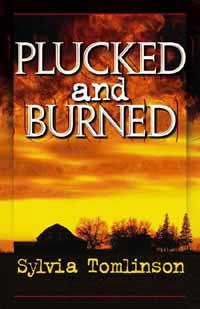Book Review
Plucked and Burned
By Sylvia Tomlinson
Redbud Publishing Company
www.redbudpublishing.com
Softcover $19.95 USA
Reviewed by Karen Davis, PhD
“Growing chickens doesn’t have to be a nightmare. It can be a good life.” p. 171

This is the premise of the people who raise chickens for the poultry industry in rural America, the contract growers in Sylvia Tomlinson’s 2003 novel concerned about their plight. If instead of perfidy, greed, corruption, and lack of conscience, the industry would grant equitable contracts and profit sharing to the men and women who put up 50 percent of the capital investment in the form of land, chicken houses and equipment—only to reap one or two percent of the profits—the growers could get on with the business of “growing” chickens and enjoying the agrarian lifestyle that, in this book, consists chiefly of barbecues, church suppers, cold beers, lattes, and stop-offs at the local diner, along with cell phones, microwaves, beepers, and automated chicken houses liable to power outages and fires, with a loss of income to growers in the form of 27,000 dead and dying birds per house to be disposed of.
Plucked and Burned casts a misty backward glance at the years between 1959 and 1970, when the more or less equitable arrangement between the growers and the chicken companies of the 1930s, ‘40s, and ‘50s dissolved, and the consolidating poultry industry crushed growers’ attempts to organize. Growers retaliated against the companies and each other by burning down one another’s chicken houses and shooting out company truck tires, but to no avail.
The novel is narrated by college-graduate grower Doug Blackwelder, whose wife Dena quit teaching to raise chickens with her husband, both of them expecting, and initially enjoying, a pretty easy life. Set in contemporary rural Oklahoma, the story opens with the suspicious death by electrocution from an ungrounded fan of a 14-year-old Mexican chicken catcher “splayed out and fried, lying face down in chicken litter, in Jimmy and Stella Rawlins’ broiler house.” From here the reader is led through the grotesque events, told in plaintive accounts, that bedevil chicken catchers, growers, and “processors” (slaughterhouse workers) in their dealings with the industry, embodied by the Bible-hugging Randall Witherwax—a Bo Pilgrim, Frank Perdue, John Tyson, George W. Bush composite whose eyes exude “the cold fire of evil masquerading behind a cloak of religiosity."
Gazing at Witherwax’s “Mansion on Mt. Pluckmore,” Doug laments the decline from the golden age of poultry growing to the iron age of today, from the grower’s point of view: “When we were in high school Randy’s parents ran a mom and pop poultry company. They treated their growers as part of the family. They lived modestly and invested the profits back into the company, sharing with the growers.”
While the overt conflict in this novel is between the growers (and peripherally the chicken catchers and slaughterhouse workers) and the industry, a deeper tension resides in the growers’ ambivalent self-image. On one hand they long only to restore a world of paternal care bestowed on them by an earthly poultry-industry Heavenly Father; on the other hand, they see themselves as models of “rugged individualism” and “independence,” though most of the growers Tomlinson interviewed were too fearful even to allow her to use their names, like the one who complained that the companies “have the ability to give you crappy birds forever and literally bankrupt you,” but who “would rather not have even a first name listed in my case.”
Despite industry corruption on every front, the majority of growers are not anti-industry, any more than are their clerical advocates, like the real-life Rev. Jim Lewis of Delaware, who throws pieces of the dead bodies of chickens to his audiences, not to confront them with the suffering comprised in those bodies, but to gain sympathy for the suffering of the catchers impressed on those bodies. As one grower says in the book, “I’m not looking for trouble. I’m just asking for people to do the right thing and show a little respect.” To achieve this goal, it is necessary, says former poultry grower, Mary Clouse, in her Foreword, to get “informed citizens, all eaters of chicken and all patriots to join in the struggle for fairness and the basic civil rights” for poultry farmers.
At the end of the story, a few characters decide to do something else for a living, as did Clouse and her husband finally, though not out of moral concern for the chickens. The birds, immured in dark “tunnel” houses, are glimpsed, as it were, in parentheses, as in: “They’ve got a million frickin’ ways to pluck us. Pardon my language, ladies, but I just got delivered 22,000 sorry biddies for my houses that are supposed to hold 27,000. On top of that, besides being puny, I think most of them are blind [and] arrived half dead. If that’s not retaliation for us trying to organize, then I don’t know the meaning of the word.”
It’s rather the way Doug looks periodically in on the current flock, and checks the automated feeders and drinkers, just long enough to make sure everything’s on schedule, and the cash will flow, or to report and clean up a disaster, between the things he actually cares about. With their microwaved hamburgers and frothy beer, Doug and Dena watch the moon rise over the chicken houses from their cozy outdoor deck, without any sense that there is something wrong with the landscape much bigger and uglier than their dream-world in ashes.